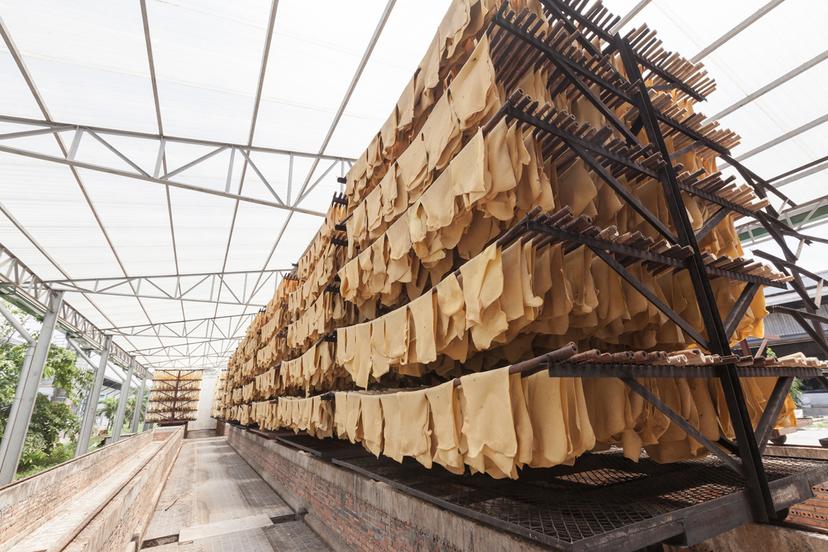Rubber

Structure
Most of the world's natural rubber is grown in the Far East, primarily Indonesia and Malaysia. Although natural rubber still accounts for some of the rubber used today, synthetic rubber is used more widely. Synthetic rubber can be produced at a cost that makes it competitive with natural rubber, and synthetic rubber has more applications. For example, some synthetic rubber has superior air retention, an important consideration in the manufacturing of tires and many other rubber products.
Natural rubber comes from latex, the milky substance of a number of plants, including the rubber tree. Rubber trees generally need six to seven years of maturity before rubber can be produced. Workers collect the latex by cutting a narrow groove in the bark of the tree and catching the latex in a cup as it flows out of the tree. Trees of rubber plantations may be tapped every day for about two weeks and then allowed to rest, or the trees may be tapped every other day. Since natural latex is only about 30 to 40 percent rubber (the other two-thirds being mostly water, with some resin and protein as well), plantations make crude rubber through a coagulation process that separates the rubber from the other components of latex.
Synthetic rubber can be produced in a variety of ways, depending on its final use. For example, styrene-butadiene synthetic rubber, which accounts for more than a third of all synthetic rubber produced, is made from mixing a gas (butadiene) and a liquid (styrene). These chemicals are combined in specific proportions in a big tank containing soap and water. The ingredients are heated or cooled and then mixed until the chemicals form a milky fluid called latex. The latex is coagulated to yield rubber.
Rubber manufacturers obtain dry rubber from plantations or from synthetic-rubber manufacturers. Rubber goods are formed from the dry rubber or sometimes from latex, which is shipped to the manufacturing plant in tank cars. Different rubber products are produced through different manufacturing processes, but generally all rubber is heated, shaped, and finished. Most of this work is done by machine.
The first step in rubber goods production is breaking up and mixing the crude rubber. Rubber cutters cut bales of crude rubber into pieces. Rubber-mill operators then mix, blend, knead, or refine the crude rubber by running it through a mill with corrugated rolls that break it apart and soften it. Plasticator machines also grind and soften rubber, making it easier to mold.
Chemists, chemical engineers, and technicians are needed to oversee the steps when the rubber is mixed with chemicals, such as carbon black, to impart desirable properties. The rubber then goes through a series of steps designed to blend and shape it into its final form. These steps include compounding, shaping, and vulcanization.
Rubber manufacturing companies provide employment to a variety of workers similar to other manufacturing industries, including machine operators, inspectors, manufacturing engineers, plant facility supervisors, office staff, and others.
Once the rubber is produced, manufacturers must find markets for the finished product. Career opportunities in sales and marketing throughout the rubber industry are among the most diversified anywhere.
For the various companies within the industry to maintain a strong market position, each must obtain its share of the available business in all markets. Since markets are constantly changing, a company's distribution network must adapt to keep pace. To improve position, it must expand faster than the market. This means constant expansion of the various retail outlets that sell rubber products to the consumer.
For the replacement tire market, the industry distributes its product mainly through independently owned dealerships and company-owned retail stores. These retail organizations provide training for many people in the industry, including those who ultimately sell to manufacturers of original equipment, such as major automobile makers.
Rubber industry salespeople generally are concerned with the sale of raw materials and finished products to business and industrial firms in the United States and foreign countries. Typical examples are the sale of tires to car manufacturers, chemicals to paint companies, and rubber piping to the oil industry.
